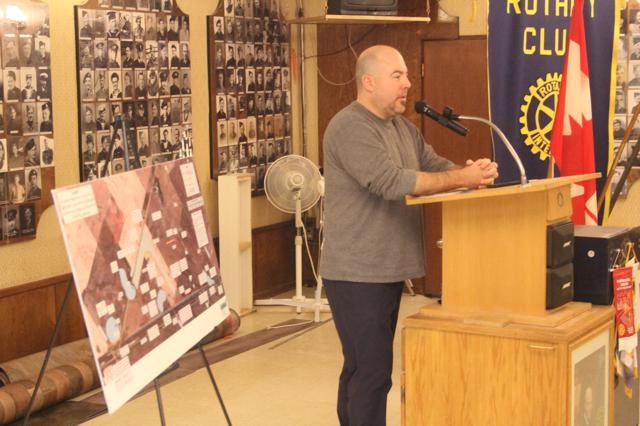By Greg Nikkel
Efforts by a local grassroots group of farmers and business owners, known as Comtrax Logistics Solutions, to build and develop a commodities hub in the Weyburn area are continuing, said Comtrax board member Dan Cugnet.
He spoke to the Weyburn Rotary Club on Thursday, updating them about the proposed hub facility and explaining what the group is hoping to provide in terms of moving different commodities ranging from grains and oilseeds to crude oil and other products, such as aggregate and fertilizer.
Explaining how the concept arose, he noted that after the failed bid to keep the Weyburn Inland Terminal in farmers hands, those who had been involved in that fight decided to wait for a while to see changes came about.
“We weren’t interested in just starting another grain company,” said Cugnet. “We asked ourselves, how do we do things differently?”
As different suggestions were made about what could be developed, they looked into what might be attractive for CP Rail to consider if they developed some sort of facility using the railway.
“The only way they can generate more revenue is by hauling more, or doing it more efficiently. We came up with a concept for a loop to increase the capacity for the CPR,” said Cugnet, noting that there are other commodities and products made in this area that could use a rail facility, such as Souris Valley Industries, which supplied much of the bleachers used in the new Mosaic Stadium in Regina.
Just in farming alone, Cugnet pointed out there are some 14 different crops being grown in and around the Weyburn area, plus commodities such as crude oil from the Bakken Formation.
The idea of the commodities hub two-loop system was developed that, if laid out right, could handle 1,000 rail cars, “which sounds aggressive, but if we have two or three more commodities, you could have one train at one site and another one loading,” said Cugnet.
He pointed out that for CP Rail to spot train cars at a site costs them about $10,000 an hour, and suggested with a commodities hub, they could be saving $30,000 to $40,000 every day, which wouldn’t take long to add up to substantial numbers.
With this scenario in mind, Cugnet said Comtrax is hoping to get some involvement by CP Rail, along with oil and grain companies who could own or lease facilities in the hub.
In relation to heavy oil producers, Cugnet suggested they could do blending of heavy oil with the medium and light oil that is produced here in the southeast, which could mean substantial dollars for oil companies if they are interested in using such a facility.
“We’re dealing with some different oil companies who are quite excited about the possibilities,” he said.
Aggregate gravel supplies is another area that be shipped by rail, as he noted area RMs need it on an ongoing basis for road maintenance, plus in the coming years the province is planning for the twinning of Highway 39, which will require a substantial amount of materials. One local example, said Cugnet, is the RM of Weyburn (on which he is a councillor), which uses roughly 20,000 yards of gravel every year, “and it’s coming from farther away each year. It’s starting to reach the point where it would make sense to bring in ballast from other jurisdictions by rail.”
For the grain part of the hub project, Cugnet said the group is still in discussion with a few different grain companies.
Comtrax is also looking into the possibility of having firms or investors putting equity dollars into the facility, possibly issuing different classes of shares. An exciting development is that Comtrax has had some multinational companies approach them about becoming involved in this project, “rather than us knocking down their doors — that’s half the battle,” said Cugnet. “The question now is, who’s going to be the first one to commit.”
For some companies, they have so many connections with other companies, they don’t want to jeopardize their economical relationships, so some firms have to be careful how they invest, if they invest anything at all.
An advantage for them is in the design on the grain and oilseed part of the project, as Cugnet noted many of the cement terminals cannot take pulse crops in due to the height the crops are taken up.
“We’re looking at bean ladders,” he said, with also the possibility of locating a pelleting mill in the middle, to make product from the grain dust.
“Part of what’s been lost is problem-solving. The way I look at problem-solving is I equate that to dollars,” he said. There are other commodity hubs that are operating, or are being planned, but none with this combination of facilities and products and services, said Cugnet, and noted one example of where this type of facility exists is on the coast of Australia.
“We’re taking different parts from here and there and putting them together,” he said. “The guys who are part of this group really understand the logistics part more than I do. I’ve learned a lot by working with them. We’ve got a great group.”
They’ve added expertise from various parts of the agricultural industry, including most recently bringing on Rob Bryson, who was formerly with Parrish & Heimbecker, and they are looking at others to bring on board, such as professionals, like accountants and lawyers.
Cugnet estimated that once a location is settled and construction begins, they will need over 200 for the construction phase, and 20 to 30 employees to run the hub.




